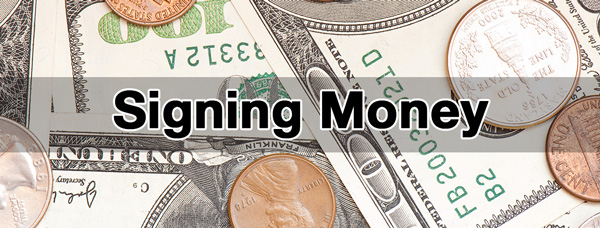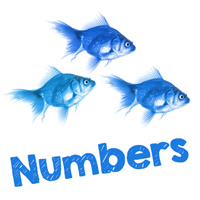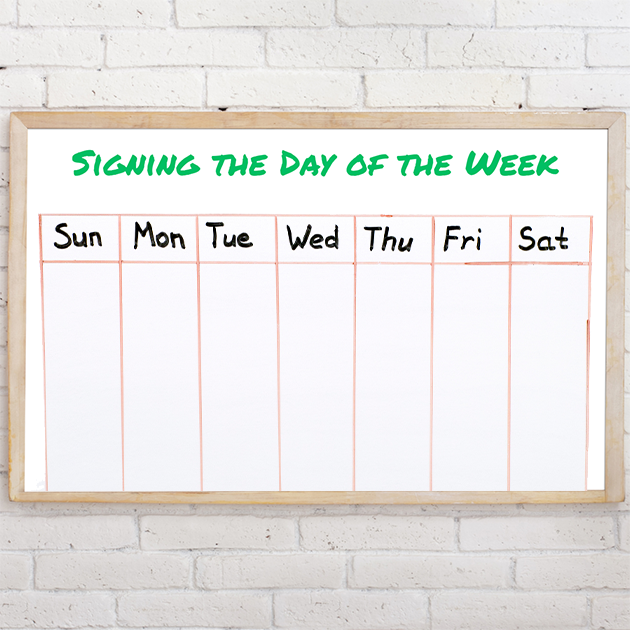
Signing Money
Getting Started — Signs to Know: the numbers, the sign for DOLLAR, and the sign for CENT
When signing money, you first need to know the signs for DOLLAR and CENT.
- The same sign is used for DOLLAR and DOLLARS.
- The same sign is used for CENT and CENTS.
 |
Sign Order — A Straightforward Way
Signing An Amount With Only Dollars
A common way to introduce signing money to new signers is to sign the number of dollars, then sign DOLLAR. This is often the way introduced first since it makes the amount and money type very clear. There is also a common way to sign $1-9 dollars with a twisting motion. We will talk more about that below.
Example: Signing One Dollar
The standard way to sign ONE DOLLAR when getting started with ASL is to sign ONE and DOLLAR. There are two widely used ways to sign DOLLAR. Here are examples using both:
 |
Signing An Amount With Only Cents
When signing only cent amounts, sign the number of cents, then sign CENT.
Signing An Amount With Dollars And Cents
Sign the quantity (number) and then followed by the unit (DOLLAR or CENT).
To sign an amount of money, you sign:
the number of dollars + DOLLARS + the number of cents + CENTS
For example, to sign $3.25, you would sign:
3 DOLLARS 25 CENTS
In this example you can see “A cookie costs $3.25.”
English: A cookie costs $3.25.
ASL Gloss: COOKIE COSTS 3 DOLLARS 25 CENTS.
Omitting the CENT Sign
In addition to signing the first way described above, which was:
- (1) # of dollars, (2) DOLLAR sign, (3) # of cents, (4) CENT sign
It is also accepted to sign money by omitting the CENT sign because it is implied after you have signed the amount and DOLLAR sign that the next number is for the cents. So you could sign:
- (1) # of dollars, (2) DOLLAR sign, (3) # of cents
Using the same example of $3.25, as listed above, the ways to sign it would be:
- 3 DOLLARS 25 CENTS (shown in video in section above)
- 3 DOLLARS 25
Using Twisting Signs for 1-9 Dollars
A common way to sign $1-9 dollars is to sign the number of dollars in front of the body with a twist. The addition of the twist replaces the sign for DOLLAR.
 |
See the Word List: 1-9 Dollars (Twisting Signs) to view all of the twisting signs for 1 to 9 dollars.
You may also use this twisting version of 1-9 dollars when signing amounts of money that include cents. You would sign the twisting dollar amount sign and then sign the amount (number) of cents. The “cents” is implied, so you do not need to sign CENTS after the amount.
However, when signing 10 dollars and up, sign the number and then sign DOLLAR.
 |
The explanation of how to sign money in the section above is how you would sign 10 dollars and up with cents.
Signing Decimals
Alternatively, you may use the DECIMAL POINT sign when signing money.
For example, to sign $3.25 with the DECIMAL POINT sign, you would sign:
3 DOLLARS DECIMAL POINT 25
If you are wondering when to use the DECIMAL POINT sign to sign an amount of money versus the variation described above, think about when the amount is $3.25 and you might say in English "Three dollars and twenty-five cents," versus "Three dot twenty-five."
Resources
ADVERTISEMENTS
 Brenda Cartwright is a Coda, seasoned interpreter, a master teacher, well known presenter, and author of several best selling sign language and interpreting textbooks from the RID Press. For 35 years Brenda was the Chair of the Sign Language Interpreter Program at Lansing Community College in Lansing, Michigan.
Brenda Cartwright is a Coda, seasoned interpreter, a master teacher, well known presenter, and author of several best selling sign language and interpreting textbooks from the RID Press. For 35 years Brenda was the Chair of the Sign Language Interpreter Program at Lansing Community College in Lansing, Michigan. Signing Math Equations
Signing Math Equations Signs That Are Close... But Not the Same — Money
Signs That Are Close... But Not the Same — Money Signs That Are Close... But Not the Same — Numbers
Signs That Are Close... But Not the Same — Numbers







